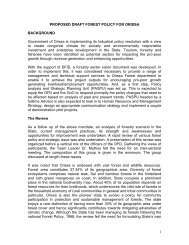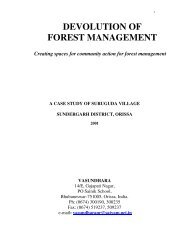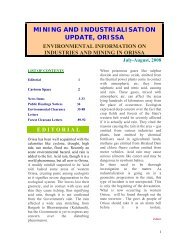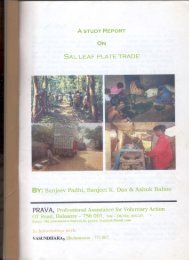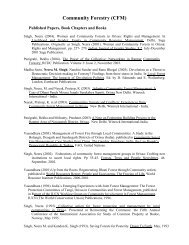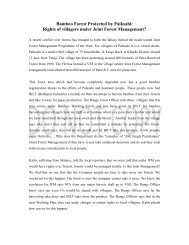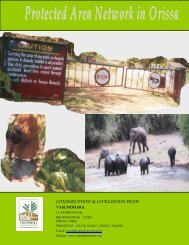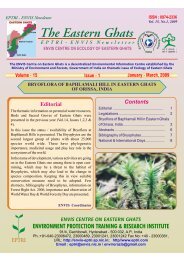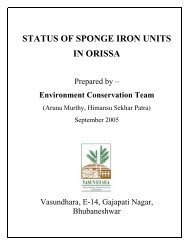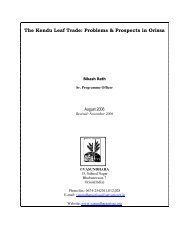Bamboo in Orissa: Trade and Livelihood Perspective - Vasundhara
Bamboo in Orissa: Trade and Livelihood Perspective - Vasundhara
Bamboo in Orissa: Trade and Livelihood Perspective - Vasundhara
Create successful ePaper yourself
Turn your PDF publications into a flip-book with our unique Google optimized e-Paper software.
All rights reserved by VASUNDHARA(www.vasundharaorissa.org). For any clarification, contact author at sunlit1968@yahoo.co.<strong>in</strong><br />
would expose the <strong>in</strong>ner parts of the same to elephants <strong>and</strong> smugglers, etc., thereby<br />
facilitat<strong>in</strong>g the damage/theft(discussion with Dilip Pradhan) although silvicultural<br />
prescriptions are there to take precautions aga<strong>in</strong>st the same.<br />
Young shoots(karadi) are not supposed to be cut. The cutters select the appropriate culms<br />
on the basis of their experience <strong>and</strong> perceptions. Culms of different ages have one or more<br />
dist<strong>in</strong>guish<strong>in</strong>g feature on them(like, presence/absence of nodal sheaths, difference <strong>in</strong> colour<br />
<strong>and</strong> also <strong>in</strong> the height to which ash-like patches are naturally found on them) which helps<br />
for their selection.<br />
The silvicultural rules also prescribe that after cutt<strong>in</strong>g, all debris should be removed from<br />
the clump, <strong>and</strong> the latter is to be left cleaned. Precautions should be taken so as to avoid<br />
any damage to rhizomes or rootstock; <strong>and</strong> exposed rhizomes should be covered with soil<br />
wherever possible(S<strong>in</strong>gh B.P., Revised Work<strong>in</strong>g Plan for the RFs <strong>and</strong> DPFs of Angul<br />
Forest Divn.:1990-91 to 1999-2000,pp.551).<br />
Dur<strong>in</strong>g summer, the cutters usually prefer to work from 6 am to 10 am; <strong>and</strong> dur<strong>in</strong>g w<strong>in</strong>ter,<br />
from 8 am to 2 pm.. This is because with a burn<strong>in</strong>g sun over their head they f<strong>in</strong>d it difficult<br />
to cont<strong>in</strong>ue work<strong>in</strong>g. However, s<strong>in</strong>ce they are paid on the basis of their harvest, many of<br />
them try to work till afternoon so as to harvest (<strong>and</strong> earn) more.<br />
Coupes <strong>in</strong> a hilly terra<strong>in</strong> are normally divided <strong>in</strong>to three compartments <strong>and</strong> the most<br />
difficult one is worked out first; i.e., cutt<strong>in</strong>g <strong>in</strong> the hill tops starts first <strong>and</strong> is over by March<br />
s<strong>in</strong>ce dur<strong>in</strong>g summer work<strong>in</strong>g <strong>in</strong> that area would be very difficult. October to December is<br />
considered to be the best time for the operation.<br />
An expert cutter can normally harvest 6 to 8 bundles of daba bamboo <strong>in</strong> 4 to 6 hours as<br />
aga<strong>in</strong>st 4 to 5 bundles of salia dur<strong>in</strong>g the same time. This is simply because a st<strong>and</strong>ard<br />
bundle of <strong>in</strong>dustrial bamboo conta<strong>in</strong>s culms each about 2.3 metres(approx. 7 ft. 6 <strong>in</strong>ches) <strong>in</strong><br />
length, <strong>and</strong> the number of pieces is only 7 <strong>in</strong> case of daba 13 as aga<strong>in</strong>st 21 <strong>in</strong> case of salia.<br />
Hence, cutt<strong>in</strong>g a bundle of salia means cutt<strong>in</strong>g 200% more culms than daba. On the other<br />
h<strong>and</strong>, the cutters are more comfortable with salia than daba because the latter conta<strong>in</strong>s<br />
thorns <strong>and</strong> is tougher for cutt<strong>in</strong>g.<br />
Salia be<strong>in</strong>g a hilly species, its harvest<strong>in</strong>g operations are normally conf<strong>in</strong>ed to hill areas. On<br />
high hills, a cutter can harvest max. 5 to 6 bundles of salia per day as aga<strong>in</strong>st 12 to 14<br />
bundles of the same <strong>in</strong> the lower slopes. Hence, the average rate of harvest per cutter per<br />
day is taken to be 8 bundles. Operations <strong>in</strong> the Dasapalla area <strong>in</strong> 2005 reportedly had a<br />
yield vary<strong>in</strong>g from 10 to 15 bundles per day per cutter, <strong>and</strong> to <strong>in</strong>clude dragg<strong>in</strong>g hours on<br />
the day of cutt<strong>in</strong>g, the average production was reduced to 12 bundles as aga<strong>in</strong>st 15 bundles<br />
without dragg<strong>in</strong>g (source: Mr. S.D.S<strong>in</strong>ha, BILT).<br />
old are to be harvested on culm-selection basis provided the number of culms left uniformly distributed <strong>in</strong> a<br />
clump should not be less than 10 (S<strong>in</strong>gh B.P., Revised Work<strong>in</strong>g Plan for the RFs <strong>and</strong> DPFs of Angul Forest<br />
Divn.:1990-91 to 1999-2000; pp.550-551).<br />
13 Earlier, a daba bundle would conta<strong>in</strong> 6 pieces, each 6 ft. 8 <strong>in</strong>ches long. OFDC probably wanted to adopt a<br />
uniform st<strong>and</strong>ard(length) for both daba <strong>and</strong> salia.<br />
32



